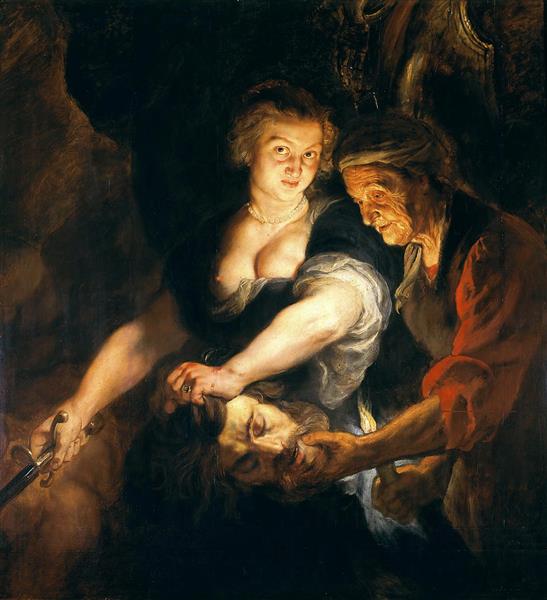Beskrivelse
Peter Paul Rubens' Judith with the Head of Holofernes, painted in 1616, stands as a powerful testament to the Flemish artist's talent and the rich artistic tradition of the Baroque. Known for his mastery of color and dynamic composition, Rubens employs a series of visual elements in this painting that not only tell a dramatic story but also evoke deep emotions and reflect the complexities of the female figure.
In the scene, Judith, the biblical heroine, is shown in the foreground, holding resolutely the severed head of Holofernes, an Assyrian general. Her expression, which combines determination and triumph, is harmonized with the posture of her body, which is turned to the right, suggesting movement and action. Holofernes' head, placed on a gilded platter, is both grotesque and impressive, highlighting the act of liberation of the Jewish people that Judith represents. Holofernes' appearance accentuates the drama of the scene, and his characteristic physiognomy, realistic and rich in detail, serves to emphasize the moral gulf between the characters.
The use of color in this work is particularly notable. Rubens deploys a rich, warm palette ranging from the golds of the tray and background to the red and black tones of Judith's clothing. These colors not only add visual depth, but also symbolize the passion and violence implicit in the act of decapitation. The texture of the clothing, illuminated by an almost dramatic light, adds to the emotional tension of the work, giving a sense of immediacy to the viewer.
Composition is another aspect to highlight. Rubens uses a kind of triangle in the arrangement of the elements: Judith at her peak, reaching out her hand towards the head of Holofernes, creates a pyramidal narrative that directs the viewer’s attention to key points in the scene. Judith’s figure, robust and determined, is contrasted with the fragility of the decapitated head, reinforcing the duality of power and vulnerability. This contrast is at the heart of the Baroque, where Rubens makes use of theatricality to capture the decisive moment that combines strength and fragility.
The work also falls within a long tradition of depictions of Judith. From Caravaggio to Artemisia Gentileschi, the tale of Judith and Holofernes has been an inexhaustible source of inspiration in art. However, Rubens’ interpretation is distinguished by its focus on celebrating Judith’s bravery, moving away from a merely tragic vision towards a more glorious representation of the female figure in action. Judith is presented not only as a femme fatale, but as a liberator, which resonates powerfully in her iconography.
Rubens disguises his technical mastery with a deep sense of cultural significance, creating a work that appeals to art lovers and scholars alike. Through his heroic approach to depicting Judith, the painter manages to reflect on the human condition and the inherent strength of the female figure, thereby bringing an emotional and social complexity that transcends its time.
The painting, in short, is not only an example of Rubens's skill in technical execution, but also invites reflection on the narrative of power, gender and resistance. "Judith with the Head of Holofernes" remains a milestone in art history, symbolizing a moment when art not only represents, but also questions and challenges normative norms, presenting Judith not as a mere object of history, but as its decisive protagonist.
KUADROS ©, a famous painting on your wall.
Hand-made oil painting reproductions, with the quality of professional artists and the distinctive seal of KUADROS ©.
Painting reproduction service with satisfaction guarantee. If you are not completely satisfied with the replica of your painting, we will refund 100% of your money.

